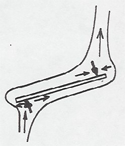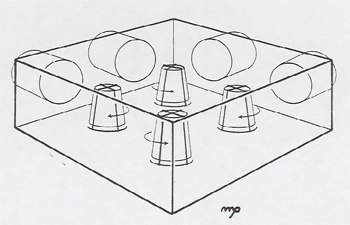- 1. Mechanics
- 2. Harmonic Motion, Waves and Sound
- A. Simple Harmonic Motion
- B. Waves
- C. Acoustics
- 10. Effects of Sound
- 10. Acoustical Interference
- 20. Acoustical Perception
- 30. Beats and Sympathetic Vibration
- 40. Bell in Vacuum
- 50. Breaking Glass with Sound
- 60. Chladni Plate
- 70. Doppler Shift
- 80. Flame Tube
- 90. Helmholtz Resonator
- 100. Kundt's Tube
- 110. Rijke Tubes
- 120. Rudnick's Acoustical Cavity and Motor
- 130. Science of Sound Tape
- 140. Voice with Helium
- 20. Musical Instruments
- 10. Effects of Sound
- 3. Matter and Thermodynamics
- 4. Electricity and Magnetism
- 5. Light and Optics
- 6. Modern Physics
- 7. Astronomy
- 8. Software and Multimedia
- 9. Index and code conversion from older manual
- External Resources
120. Rudnick's Acoustical Cavity and Motor
Four small loudspeakers are used to excite standing waves in a plexiglass "room" 40 ¥ 40 ¥ 12 cm high. At 400 Hz one half wave fits in the 40 cm. About 140 dB of sound can be established in the "room". An audio oscillator feeds channels A and B through a stereo amplifier, but one channel is phase shifted 90° to the other. A reversing switch is provided to change the 90° "lead" to "lag". Thus, by using the balance control one set of speakers, or the other, or both, 90° out of phase, can be excited. By engaging the monaural mode the two signals are added, and both sets of speakers receive the same phase signal. A sample set of demonstrations is described below.

- First establish that the stable position of a card in an air flow is perpendicular to the air flow, contrary to naive intuition. This is a Bernoulli effect, and can be demonstrated by dropping playing cards "flat" and "edge-on." The "flat" position is more stable.
- A card is hung from a thread in the "room" . When channel A or B alone is excited (using the balance control), the card will turn to face the exciting pair of speakers. When both channels are excited in phase (monaural engaged), the card will turn 45° from the sets of speakers. The 45° orientation can be reversed by changing the phase reverse switch. When both channels are excited "in stereo", the card will rotate continually. The rotation can be reversed by changing the phase reverse switch.

- Helmholtz resonators (Christmas tree ornaments) on a bar (see first figure) will rotate rapidly when the "room" is excited in any mode (Rudnick's acoustical motor). The ornaments resonate at the 400 Hz of the "room", and the ejecting air stream established in Helmholtz Resonator provides the rotational thrust.
- The frequency is now doubled to 800 Hz so that two half-waves are established across the "room". Four styrofoam cups with racing stripes are placed on pivots in the four quadrants of the "room". When the speakers are energized, the cups counter-rotate as shown in the figure below.

